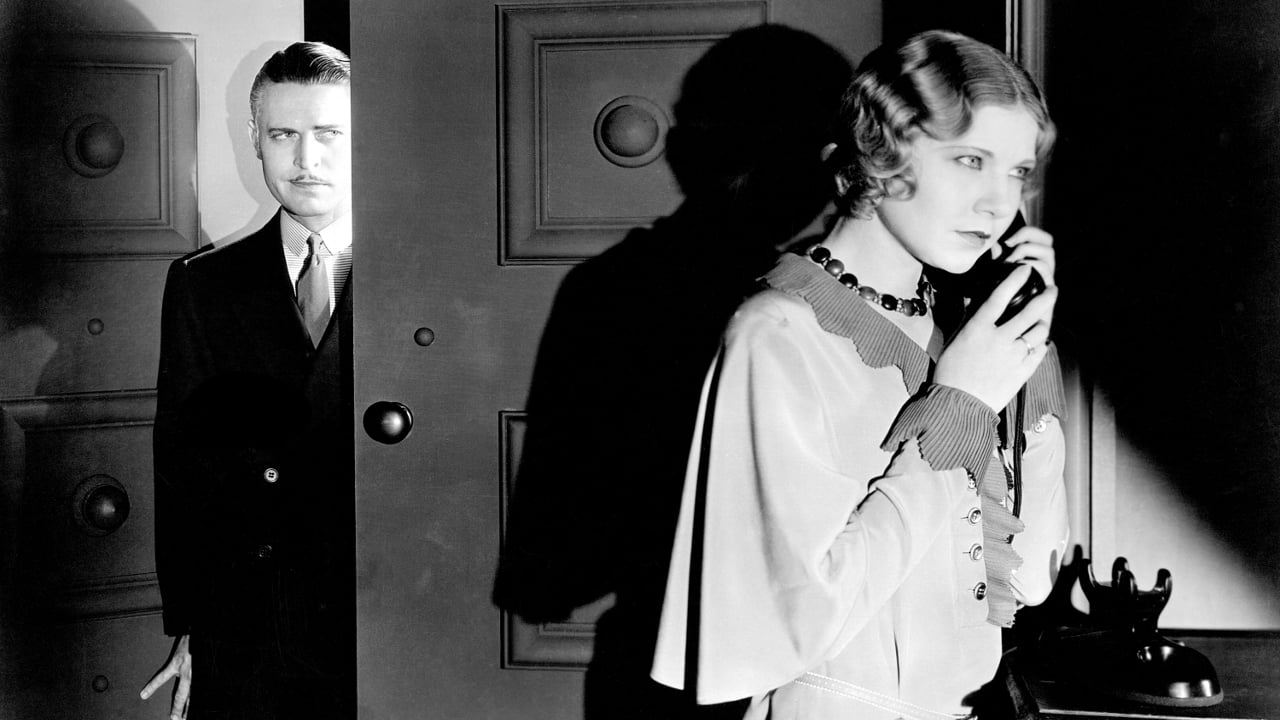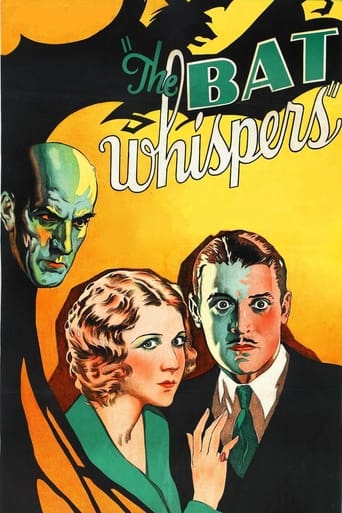

Wonderfully offbeat film!
... View MoreStylish but barely mediocre overall
... View MoreA lot of perfectly good film show their cards early, establish a unique premise and let the audience explore a topic at a leisurely pace, without much in terms of surprise. this film is not one of those films.
... View MoreGreat example of an old-fashioned, pure-at-heart escapist event movie that doesn't pretend to be anything that it's not and has boat loads of fun being its own ludicrous self.
... View More"The Bat Whispers" boasts striking, spacious sets and some remarkably (for 1930) fluid camera-work, but it still can't completely shake off its staginess, and it includes not one, not two, but three unfunny comic relief supporting characters (the maid's squealing is absolutely insufferable). As for who The Bat is, it is possible after a point to put 2 and 2 together and figure it out before he is unmasked. But the final 2 minutes are most unusual - for this ending, and the visuals, the film is worth a look. **1/2 out of 4.
... View MoreThe gong-ing sound played over the opening credits was exactly the same as the one produced by an old clock in the attic of my house when I was just a kid, going back almost sixty years now. I discovered it on one of my forays upstairs and nearly jumped out of my shorts when I accidentally got it to chime. The room had pretty much the same old dark house atmosphere of the mansion in this movie, and with very little lighting, the thing just scared the bejeezus out of me. But eventually I got over it and managed to play it over and over again as the weeks went by. I had to quit though when I found out a gorilla lived up there, that was about the same time I saw "King Kong" for the first time.So this picture must have had it's fans back in the very early days of talking movies, and for that one can give it some credit. It doesn't take too long to realize that there might have been some inspiration here for the character of Batman in the comic book world, who made his debut in Detective Comics #27 in May of 1939. So that was almost a full decade later. Not only the character, but there was also that cool smokescreen effect produced by the getaway car right after the 'Bat' pulled off the bank heist. Add to that the various pulleys and ropes the Bat used in the story and you had a lot of early material being tested out here for the Caped Crusader to put into his repertoire.Story wise though, unless you're a patient sort and willing to watch just about anything (which I am), the picture can be a chore. The best thing going for it in my estimation was the great atmospherics - the dark corridors, the revolving fireplace and that makeshift laundry chute that got used a couple of times. It appears the film makers were going for comedy along with the horror/mystery element, and I couldn't help thinking that it would have passed muster if Laurel and Hardy might have shown up. But gee, most of the players wound up screeching or going into exaggerated hysterics whenever something ominous was about to happen, and for me that was something of a turn-off.And Chester Morris - man, his facial expressions were just hilarious. I guess I should have seen it coming but I didn't - when he revealed himself to be The Bat I thought it was just the dumbest thing. Here he's proclaiming "I've got the greatest brain that ever existed" while his foot's caught in a bear trap and he's wrapped in a chain by the unwitting action of some other characters. It occurred to me that all of this could have been avoided if Detective Anderson (Morris) simply didn't show up. As the Bat he pulled off the jewel heist and bank robbery, so why was he even at the Van Gorder mansion to investigate a jewel heist and bank robbery? But the best had to be the time Dr. Venrees (Gustav von Seyferrtitz) began wildly shooting at the presumed villain escaping up the stairs. With his first four shots fired, there were already more than a dozen bullet holes in the wall! It's enough to drive you batty.
... View MoreTHE BAT WHISPERS has a convoluted history. Mary Roberts Rinehart (1876-1957) created this tale of a master criminal skulking around a creepy country mansion as the 1907 novel THE CIRCULAR STAIRCASE. In 1917 Rinehart and playwright Avery Hopwood to adapted it to the stage. Retitled THE BAT, in 1920 it took Broadway by storm with its mixture of crazy characters, corny situations, and spooky atmosphere, and in 1926 film director Roland West brought the play to the screen. Once again it proved a great success; not only was the film an audience favorite, it was critically well-regarded too.It was also made just as sound began to roar. In 1930 West decided to remake the film as a "talkie." He also decided to add a few innovative bells and whistles in a visual sense as well. Many directors of early sound films had enough to do in coping with sound technology--and so they tended to lock the camera down, a circumstance that gave most Hollywood films made between about 1929 and 1933 a visually static quality. Not so West: THE BAT WHISPERS would be noted for a remarkably fluid camera that made the most of detailed miniatures and lavish sets. But more than this, THE BAT WHISPERS would truly stun audiences of the day via a widescreen format.Widescreen format? In 1930? Surprising, yes, but true. Directors had tinkered with widescreen formats since the silent era, with French director Able Gance's 1927 masterpiece NAPOLEON a case in point--but although interesting, the results were hit and miss. With THE BAT WHISPERS, cinematographer Robert H. Planck nailed it flawlessly. He also left something of a puzzle: film historians are still not entirely sure how he brought it off. Most records seem to indicate that Planck actually shot the film on 35 mm, and then somehow managed to paste, cut, process, and reprint the original footage onto 70 mm. Regardless of how it was done, the result is astonishing, and every one who saw the film was amazed.Unfortunately, those who saw it were few and far between. Theatre owners were still recovering from the expense of buying audio systems and they were not in a mood to pay for an expensive new screen and projection system as well. When the film went into general release, it went in standard ratio filmed by cinematographer Ray June. Again, it is hard to say exactly how this was done, but looking at both versions it would seem that June took a fair amount of Planck's footage, cropped it, and then re-shot most key scenes directly onto 35 millimeter stock.We now come to something of a paradox. Planck's widescreen version is both visually beautiful and innovative--but Planck and director West were pretty much working without any precedent and they weren't quite sure of what do with the effect once they had it. Virtually everything is done in long shot, and when the camera isn't in motion THE BAT WHISPERS feels dry as dust and twice as slow. The June version, however, makes solid use of close-ups and medium shots, and while it sometimes feels a bit jumpy it has a better flow and a significantly better pace. Ironically, the June version is actually the more watchable of the two.But I use the word "watchable" in a comparative sense here. The style of acting that worked so well for silent film proved horrifically awkward in sound film, and directors and actors struggled for several years to find a new acting technique. Both versions of THE BAT WHISPERS find the cast struggling in the gulf between old and new. The Planck version tends to highlight the difficulties involved; the June version softens them--but whether it be Planck or June, the performances are chiefly notable for their awkward quality.The plot is also antiquated. Part of the charm of the novel, the 1920 play, and the 1926 film was the use of already old-fashioned plot ideas that had not yet worn out their welcome--but by 1930 the whole thing was wearing very thin, and it emerges here as overworked and lacking the necessary light touch. Every thing about the story had become very clichéd, and two years later director James Whale would wickedly spoof the entire genre with a film aptly titled THE OLD DARK HOUSE. Although the Rinehart story received one more major turn before the cameras in 1959 with Vincent Price and Agnes Moorehead, the type of plot involved is now more often done tongue-in-cheek, with such films as MURDER BY DEATH and CLUE cases in point.So what, exactly, is the value of THE BAT WHISPERS for a modern, casual viewer? The answer, rather sadly, is "not much." Hardcore fans of early 1930s film will likely enjoy the film, and film students interested in the history of cinematography cannot afford to miss it--but few others will be able to see beyond the awkward acting styles and now-absurd plot to experience the charm this film--in both widescreen and standard versions--had in 1930.The IMAGE DVD release is a bit problematic. In terms of picture, the standard ratio version has the occasional blip and blemish but has weathered very well. Although it has been restored, artifacts abound in the widescreen version; even so, the picture is very clean and they do not significantly detract from the film. Sound quality is a problem in both versions, less so in the standard ratio version, more so in the widescreen version. To some extent, this may be due to the recording technology of the era (actors tend to become fainter as they move away from the center of the sets), but it seems safe to say that the entire sound balance is off on this DVD release. You'll have to turn up the volume all the way to hear it--and where the widescreen version is concerned you'll also have to sit by the speakers.GFT, Amazon Reviewer
... View MoreA tour-de-force of chases, shootouts, and robbery, as "The Bat" terrorizes a city, and particularly the renters of a mansion where he makes his hideout. Nearly everybody is a suspect, but the key lighting pretty much gives it away. Nonetheless, West keeps the pace moving so fast that we don't really have time to stop and think about much of anything. Features West's trademark effects with miniatures and wires. Some remarkable photography (in 65mm, no less) in the disappearing silent gothic tradition makes this movie a link from the newly emerging horror scene to the old "haunted house with criminals" genre into which it more properly falls. "Goofy gothic" excellence.
... View More